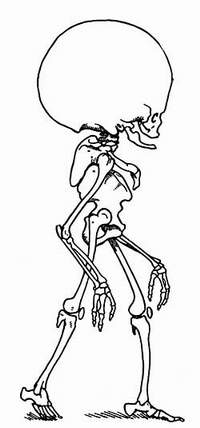Evolution to make humans look like egg-skulled big-headed creatures
The shape of the human skull has changed significantly over the last 650 years. The modern man’s facial features do not protrude as mush as those of the Middle Ages man did. And the forehead of the modern man is higher than the forehead of his predecessor, according to researchers at the University of Birmingham. They examined 30 skulls unearthed in 1980 from a common grave of the victims of the 14th century plague in London. They also examined 54 skulls found in the wreckage of Mary Rose, which sank off the south coast of England in 1545. Researchers conducted a comparative study of the skulls from the past and present.

As reported by BBC News, a team of archeologists headed by Dr. Peter Rock has discovered two fundamental differences while examining the skulls. Man in the Middle Ages had more protruding facial features. However, the vault of his skull i.e. distance from the eyes to the highest point of the skull was narrower than that of the modern man. The vault of the skull has increased by nearly 20% since the Middle Ages. In other words, the term “egghead” can be aptly used for describing the modern homo sapiens. The authors of the study believe that the changes can be explained by the evolution of man’s mental abilities.
Taking a more retrospective viewpoint on the issue, there is no point in defying the fact that the volume of the average adult human brain has increased four times over the period of evolution lasting about 5 million years, from 300 cubic centimeters to 1,400 cubic centimeters. How matter how pleasing this explanation can be, the story is more banal and has nothing to do with hypertrophy of mental abilities.
“The changes have to do with a smaller amount of work done by our dental equipment because we do not have to do a lot of gnawing or biting any more,” said Dr. Lev Etingen, a professor of the anatomy department of the Sechenov Medical Academy in Moscow. “Today we do not need the wisdom teeth very much. The wisdom teeth are the third molars on each side of either jaw. Some present-day newborns do not have the third molars. In short, the skull’s structural changes on record largely relate to the masticatory muscles,” said Dr. Lev Etingen.
In view of the above, the most intriguing question can look like this: Were the changes caused by the respective changes in the human genome? Are the observable processes simply phenotypic by origin?
“Statistics indicate that an average height of the human being in most parts of the world is growing continuously,” says U.S. geneticist John Glad in his book The Future Evolution of Man.
The trend does not stem from the changes in the genes, it has to do with a better diet. However, genotype imposes certain restrictions. If the Pygmies eat excellent food while people of the Masai tribe feed on low-quality victuals, the height curve of Pygmies will rise steadily and the height curve of the Masais will drop. The Pygmies will not grow taller than the Masais, though. Contrary to the Lamarckian theory, the tall height characteristics will not be passed on to children,” says Glad.
Dr. Etingen shares a similar point of view. “I can’t give a straight answer to this question. At the same time, the changes are very likely to be of phenotypic nature,” said he when asked to comment on the comparative data produced by the study of the British anthropologists. “The teeth of our ancestors were stronger than ours, and less susceptible to caries. The teeth began to deteriorate in the 16th century after people started eating brown sugar. There is even a regularity showing that the size of a tooth diminishes by 1% every one thousand years. The human tooth has decreased by 45% over the last one hundred thousand years.
These days we teach our students that man has 32 teeth. Looks like man’s going to have only 21-22 teeth several thousand years, and the number will not cause any trouble to man,” said Dr. Etingen.
It seems obvious that man has not stopped developing in terms of physiology. “Homo sapiens is a very young link in the evolution chain,” points out John Glad. The conditions regulating the selection in this population have undergone revolutionary changes during the last one hundred years,” says he. In the last decade alone children have become not only taller but thinner as well, according to anthropological data.
In light of the above, it is worth reminding that the size of the brain of homo sapiens is confined to the size of the cranium, which is restricted by the size of the parturient canal. In theory, such new reproductive technologies as cloning or artificial insemination in vitro may make the “curse” of a narrow pelvis history. The increasingly sophisticated biotechnologies will probably bring about another twist of evolution resulting in the appearance of “bigheaded people” as opposed to the present-day bony “eggheads”.
Nezavisimaya Gazeta
Translated by Guerman Grachev
Discuss this article on Pravda.Ru English Forum
Subscribe to Pravda.Ru Telegram channel, Facebook, RSS!




